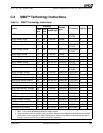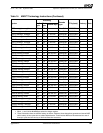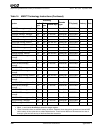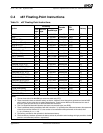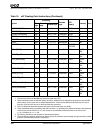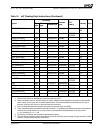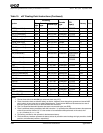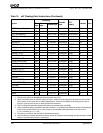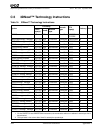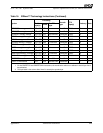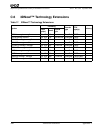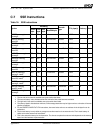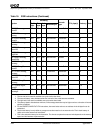
Appendix C Instruction Latencies 311
Software Optimization Guide for AMD64 Processors
25112 Rev. 3.06 September 2005
FMUL [mem32real] D8h mm-001-xxx DirectPath FMUL 6
FMUL [mem64real] DCh mm-001-xxx DirectPath FMUL 6
FMULP ST(i), ST DEh 11-001-xxx DirectPath FMUL 4 1
FNCLEX DBh E2h VectorPath 16
FNINIT DBh E3h VectorPath 89
FNOP D9h 11-010-000 DirectPath FADD/FMUL/
FSTORE
22
FPATAN D9h 11-110-011 VectorPath - 136
FPREM D9h 11-111-000 DirectPath FMUL 9+e+n 4
FPREM1 D9h 11-110-101 DirectPath FMUL 9+e+n 4
FPTAN D9h 11-110-010 VectorPath - 107
FRNDINT D9h 11-111-100 VectorPath - 10
FRSTOR [mem94byte] DDh mm-100-xxx VectorPath - 138
FRSTOR [mem108byte] DDh mm-100-xxx VectorPath - 138
FSAVE [mem94byte] DDh mm-110-xxx VectorPath - 159
FSAVE [mem108byte] DDh mm-110-xxx VectorPath - 159
FSCALE D9h 11-111-101 VectorPath - 9
FSIN D9h 11-111-110 VectorPath - 93
FSINCOS D9h 11-111-011 VectorPath - 104
FSQRT D9h 11-111-010 DirectPath FMUL 35
FST [mem32real] D9h mm-010-xxx DirectPath FSTORE 2
FST [mem64real] DDh mm-010-xxx DirectPath FSTORE 2
FST ST(i) DDh 11-010xxx DirectPath FADD/FMUL 2
FSTCW [mem16] D9h mm-111-xxx VectorPath - 4
FSTENV [mem14byte] D9h mm-110-xxx VectorPath - 89
Table 15. x87 Floating-Point Instructions (Continued)
Syntax
Encoding
Decode
type
FPU
pipe(s)
Latency Note
First
byte
Second
byte
ModRM byte
Notes:
1. The last three bits of the ModRM byte select the stack entry ST(i).
2. These instructions have an effective latency as shown. However, these instructions generate an internal NOP
with a latency of two cycles but no related dependencies. These internal NOPs can be executed at a rate of
three per cycle and can use any of the three execution resources.
3. This is a VectorPath decoded operation that uses one execution pipe (one ROP).
4. There is additional latency associated with this instruction. “e” represents the difference between the exponents
of the divisor and the dividend. If “s” is the number of normalization shifts performed on the result, then
n = (s+1)/2 where (0 <= n <= 32).
5. The latency provided for this operation is the best-case latency.
6. The three latency numbers represent the latency values for precision control settings of single precision, double
precision, and extended precision, respectively.



